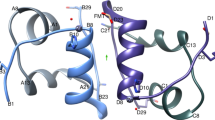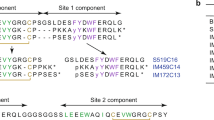Abstract
ON account of its stability and well-defined crystalline character, insulin is a favourable point at the present time to attack protein structure. Its composition is probably better known than that of any other protein. The stoichiometrical molecular weight, that is, the least Weight into which all the analytical values can be fitted, is 12,000, indicating a comparatively simple character1. Recent researches2 show that the most prevalent molecule in aqueous solution has a molecular weight approximately four times as great, dissociating somewhat in acid and moderately alkaline solutions. The facts, therefore, suggest that the basic unit of insulin is a molecule of molecular Weight 12,000. X-ray analysis has indicated that three of these units form the unit cell in crystals3.
This is a preview of subscription content, access via your institution
Access options
Subscribe to this journal
Receive 51 print issues and online access
$199.00 per year
only $3.90 per issue
Buy this article
- Purchase on Springer Link
- Instant access to full article PDF
Prices may be subject to local taxes which are calculated during checkout
Similar content being viewed by others
References
Chibnall, A. C., Proc. Roy. Soc., B, 131, 136 (1942); Second Proctor Memorial Lect., J. Inter. Soc. Leather Trades Chemists, 30, 1 (1946).
Gutfreund, H., Biochem. J., 42, 136 (1948).
Crowfoot, D., Proc. Roy. Soc., A, 164, 580 (1938).
Sanger, F., Biochem. J., 39, 507 (1945).
Toennies, G., and Homiller, R. P., J. Amer. Chem. Soc., 64, 3054 (1942).
Sanger, F., Nature, 160, 433 (1947).
Sanger, F., Nature, 160, 295 (1947).
Private communication.
Sprince, H., and Woolley, D. W., J. Amer. Chem. Soc., 67, 1734 (1945).
Woolley, D. W., J. Biol. Chem., 171, 443 (1947).
Craig, L., J. Biol. Chem., 155, 519 (1944); with others, ibid., 161, 321 (1945); 162, 363 (1946).
Woolley, D. W., Fed. Proc., 7, 200 (1948).
Butler, J. A. V., Dodds, E. C., Phillips, D. M. P., and Stephen, J. M. L., Biochem. J., 42, 116, 122 (1948).
Phillips, D. M. P., (in preparation).
Private communication.
Author information
Authors and Affiliations
Rights and permissions
About this article
Cite this article
BUTLER, J., PHILLIPS, D. & STEPHEN, J. The Core of the Insulin Molecule. Nature 162, 418–419 (1948). https://doi.org/10.1038/162418a0
Issue Date:
DOI: https://doi.org/10.1038/162418a0
Comments
By submitting a comment you agree to abide by our Terms and Community Guidelines. If you find something abusive or that does not comply with our terms or guidelines please flag it as inappropriate.



